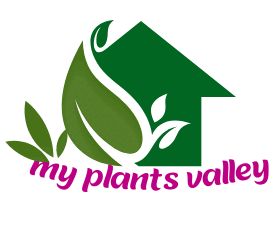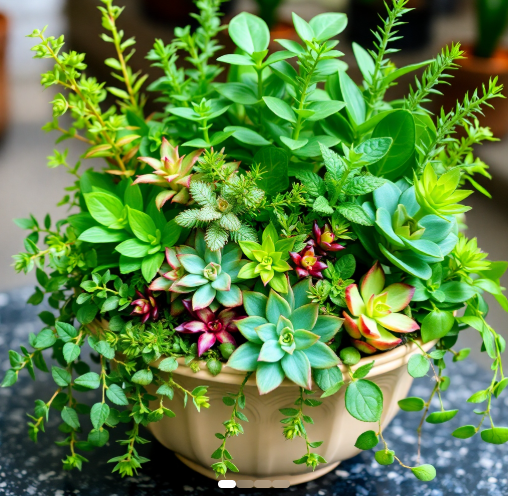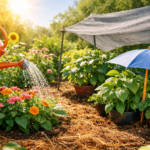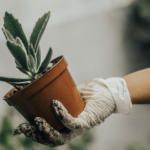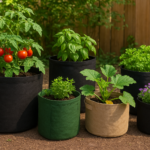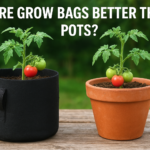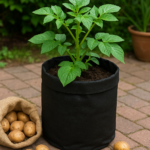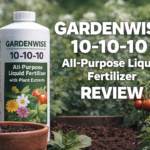Potted plants are a fantastic way to bring nature indoors or brighten up your outdoor space, offering both beauty and practicality. But have you ever wondered how many plants you can grow in a single pot? While it’s tempting to mix and match your favorite plants, the success of your arrangement depends on careful planning. Factors like pot size, plant compatibility, and maintenance requirements all play a role in creating a thriving mini-garden.
In this guide, I’ll walk you through everything you need to know about planting multiple plants in one pot, from selecting the right combinations to avoiding common pitfalls. Whether you’re aiming for a lush display of greenery or a vibrant mix of flowers, understanding the basics will help you achieve a harmonious and healthy potted arrangement. Let’s dive in and uncover the secrets to growing multiple plants in one pot successfully!
Why Potted Plants Are Popular?

Potted plants have become a favorite for homes and gardens, thanks to their versatility and convenience. They’re perfect for small spaces, allowing you to enjoy greenery even in apartments, balconies, or patios. Whether you want to add a splash of color to your living room or grow herbs for your kitchen, pots make it possible without needing a large garden.
Another reason for their popularity is mobility. You can easily move pots to find the best lighting or rearrange them for a new look. They’re also great for experimenting with different plant types, from flowers and vegetables to succulents and decorative foliage.
Potted plants provide better control over soil quality and moisture levels, making them ideal for beginners and seasoned gardeners alike. Plus, they’re a creative outlet! With endless designs, colors, and shapes, pots let you express your style while adding life to your surroundings.
Factors to Consider Before Planting Multiple Plants

When planting multiple plants in a single pot, it’s essential to consider several factors to ensure they thrive together. Here’s what to keep in mind:
1. Pot Size:
Choose a pot large enough to accommodate all plants comfortably. The roots need space to grow without overcrowding, or the plants may compete for nutrients and water.
2. Plant Compatibility:
Pair plants with similar needs. Mixing sun-loving and shade-loving plants or combining those with different watering requirements can lead to poor growth for some.
3. Growth Habits:
Consider how each plant grows. Tall plants may overshadow smaller ones, while spreading plants can invade the space of more compact varieties.
4. Root Systems:
Ensure the root systems are compatible. Shallow-rooted plants work well together, while deep-rooted plants need more space. Avoid pairing aggressive roots with delicate ones.
5. Drainage Requirements:
All plants in the pot should have similar drainage needs. Use soil that retains the right amount of moisture and ensure proper drainage to avoid waterlogging.
6. Aesthetic Balance:
Think about visual harmony. Combine plants with varying heights, textures, and colors for a balanced and attractive arrangement.
Benefits of Planting Multiple Plants Together
Planting multiple plants together in the same pot offers several advantages, both practical and aesthetic. Here are some key benefits:
1. Aesthetic Appeal
A well-planned combination of plants creates a visually stunning display. Mixing different colors, textures, and heights enhances the pot’s overall beauty, making it a centerpiece for your home or garden.
2. Space Efficiency
If you have limited space, combining plants in one pot allows you to maximize your greenery without overcrowding your area. This is perfect for apartments, balconies, or compact gardens.
3. Improved Growth
Certain plants benefit from being close to others. Companion planting, for instance, can boost growth by improving nutrient sharing or deterring pests.
4. Simplified Maintenance
Grouping plants with similar care needs simplifies your watering and fertilizing routine. You can tend to all plants in the same pot at once.
5. Natural Microclimates
Larger plants can provide shade and protect smaller, delicate ones from harsh sunlight or wind, creating a supportive environment for growth.
6. Cost-Effective
Instead of buying separate pots and soil for each plant, you save resources by planting multiple plants in one pot.
Challenges of Overcrowding
Planting multiple plants in one pot can be rewarding, but overcrowding comes with its challenges. Here are the key issues you may face:
1. Limited Resources
Overcrowded plants compete for water, nutrients, and sunlight. This can lead to stunted growth as no single plant gets enough resources to thrive.
2. Poor Air Circulation
When plants are packed tightly, airflow around them decreases. This creates a humid environment that can encourage fungal infections and other diseases.
3. Increased Risk of Pests
Dense planting can attract pests like aphids and spider mites, which thrive in close quarters. Controlling infestations becomes harder in overcrowded pots.
4. Root Competition
Roots need space to grow and spread. In an overcrowded pot, plants’ roots may tangle or compete for soil space, leading to weak and unhealthy plants.
5. Uneven Growth
Taller or faster-growing plants may overshadow smaller ones, blocking access to sunlight. This can cause uneven development and poor plant health.
6. Frequent Maintenance
Crowded pots require more attention, including frequent watering and pruning, to prevent decline.
Choosing the Right Plants for the Same Pot
Choosing the right plants for the same pot is essential to ensure they thrive together without competing for resources. Here’s what to consider:
1. Similar Light Needs
Select plants that share the same sunlight requirements. For example, sun-loving plants like petunias and geraniums thrive together, while shade-loving plants like ferns and calatheas make great companions.
2. Matching Water Requirements
Pair plants that require similar watering schedules. Overwatering a drought-tolerant plant or underwatering a moisture-loving one can harm their growth.
3. Compatible Growth Habits
Combine plants with complementary growth patterns. For instance, mix tall plants with trailing ones to create balance and ensure each plant gets enough light. Avoid aggressive growers that may overshadow or crowd out others.
4. Compatible Root Systems
Plants with similar root systems coexist better. Shallow-rooted plants like lettuce or succulents pair well, while deep-rooted plants like tomatoes need more space.
5. Aesthetic Appeal
Choose plants with contrasting textures, colors, and heights to create a visually appealing arrangement. For example, mix spiky grasses with soft, trailing ivy for variety.
Types of Arrangements
When planting multiple plants in one pot, there are a few popular arrangement styles that can enhance both the health of the plants and the aesthetic appeal. Here are the common types:
1. Thrillers, Fillers, and Spillers
This classic arrangement involves using three types of plants to create balance and visual interest.
- Thrillers: Tall, eye-catching plants like ornamental grasses or dracaena, which form the focal point.
- Fillers: Medium-height plants with bushy growth, such as geraniums or coleus, to fill out the arrangement.
- Spillers: Trailing plants like ivy or sweet potato vine that cascade over the pot’s edges, adding movement and flow.
2. Companion Planting
Companion planting groups plants that benefit each other’s growth. For example, marigolds can be planted with vegetables like tomatoes to deter pests, improving overall plant health.
3. Symmetrical Arrangement
In a symmetrical arrangement, plants of equal height and size are placed evenly around the pot. This works well for formal settings or to create a neat, uniform look.
4. Mixed Heights and Textures
For a more natural and relaxed style, combine plants with varying heights and textures. Use a mix of tall, bushy, and trailing plants for a dynamic, visually interesting arrangement.
How to Prepare Your Pot
Preparing your pot properly is essential for creating a healthy environment for your plants to thrive. Here’s a step-by-step guide:
1. Choose the Right Pot
Select a pot with adequate size to fit all the plants you plan to grow. Ensure it has drainage holes at the bottom to prevent waterlogging.
2. Clean the Pot
If you’re reusing a pot, clean it thoroughly to remove any dirt, old soil, or pathogens that could harm your plants. Use warm, soapy water and rinse well.
3. Add Drainage Material
Place a layer of stones, pebbles, or broken clay pieces at the bottom of the pot. This helps improve drainage and prevents roots from sitting in water.
4. Use Quality Potting Soil mix
Fill the pot with high-quality potting soil that is nutrient-rich and well-draining. Avoid garden soil, which can compact and suffocate roots in pots.
5. Moisten the Soil
Lightly water the soil before planting to ensure it is evenly moist. This makes it easier to plant and provides an initial water supply for your plants.
6. Arrange Plants
Position the plants in the pot while still in their nursery containers to decide the best layout before planting them.
Steps to Plant Multiple Plants in One Pot

Planting multiple plants in one pot requires careful planning to ensure they grow together harmoniously. Here are the steps to follow:
1. Choose the Right Pot
Start with a pot that’s large enough to accommodate all your plants, leaving space for root growth. Ensure it has drainage holes to prevent waterlogging.
2. Prepare the Pot
Add a layer of drainage material like pebbles or broken pottery at the bottom of the pot. Then, fill the pot halfway with good-quality potting soil.
3. Arrange the Plants
Before planting, arrange the plants in the pot while they are still in their nursery containers. This helps you visualize the layout and ensures the plants won’t overcrowd each other. Place taller plants in the center and shorter ones around the edges.
4. Plant the Plants
Gently remove each plant from its container, loosening the roots if they are root-bound. Place them in the pot and fill in the gaps with soil, ensuring the root balls are at the same level as the soil surface.
5. Water the Plants
Once all plants are positioned and the soil is settled, water thoroughly. This helps eliminate air pockets and gives the plants a good start.
6. Add Mulch
Top the soil with a layer of mulch to help retain moisture and regulate soil temperature.
Common Mistakes to Avoid
When planting multiple plants in one pot, it’s easy to make mistakes that can affect the health and growth of your plants. Here are some common errors to avoid:
1. Choosing Incompatible Plants
One of the biggest mistakes is selecting plants with different care needs. Mixing plants that require varying amounts of sunlight, water, or soil conditions can lead to poor growth and even plant death. Always pair plants with similar needs.
2. Overcrowding the Pot
Trying to fit too many plants in a small pot can cause overcrowding, leading to competition for resources. This limits root space, reduces airflow, and increases the risk of disease. Ensure each plant has enough room to grow.
3. Ignoring Drainage
Good drainage is crucial for plant health. Without proper drainage, water can pool at the bottom of the pot, causing root rot. Always ensure your pot has sufficient drainage holes and consider adding a layer of pebbles for extra drainage.
4. Using the Wrong Soil
Using garden soil instead of potting soil can lead to poor drainage and compaction. Potting soil is specifically designed to promote root growth and proper moisture retention.
5. Not Watering Properly
Overwatering or underwatering is a common mistake. Each plant has specific watering needs, and not adjusting for this can harm the roots. Check the soil moisture regularly and water accordingly.
6. Neglecting Maintenance
Plants in shared pots may need more frequent pruning, repotting, and monitoring for pests. Don’t forget to regularly inspect your plants to keep them healthy and thriving.
How to Maintain a Multi-Plant Pot
Maintaining a multi-plant pot requires consistent care to keep all plants healthy and thriving. Here are some tips to ensure your arrangement flourishes:
1. Regular Watering
Water your multi-plant pot according to the needs of the plants. Check the soil moisture regularly, and avoid overwatering or underwatering. Plants in the same pot should have similar watering needs, but always make adjustments if one plant needs more or less water.
2. Pruning and Deadheading
Remove dead leaves, flowers, or stems to encourage new growth and prevent disease. Regular pruning helps keep plants from becoming too leggy or overcrowded. Trim any plants that are growing too tall or invasive to maintain balance in the pot.
3. Fertilizing
Feed your plants with the right type of fertilizer. Use a balanced, slow-release fertilizer to provide steady nutrients, or a liquid fertilizer for faster absorption. Be careful not to over-fertilize, as this can harm the plants or cause them to grow too quickly.
4. Check for Pests
Inspect your plants regularly for pests like aphids, spider mites, or mealybugs. If you notice any signs of infestation, treat the plants immediately with natural or chemical pest control methods.
5. Re-potting When Needed
As plants grow, they may outgrow their pot. If you notice that the plants are becoming too crowded or root-bound, consider repotting them into a larger container to give them more space.
6. Provide Proper Light
Ensure your plants get the right amount of light based on their individual needs. Rotate the pot occasionally to give all plants equal exposure to light, especially if they have different light requirements.
How to Maintain a Multi-Plant Pot
Maintaining a multi-plant pot requires attention to detail and regular care to keep your plants thriving. Here are some essential practices for long-term plant health:
Pruning and Trimming
Regular pruning is key to maintaining a healthy pot. Remove dead or damaged leaves, flowers, and stems to encourage new growth. Trim back any plants that are growing too aggressively or crowding others. This helps maintain balance and ensures each plant has enough space to grow.
Monitoring Soil Health
Soil health is critical for your plants’ overall well-being. Keep an eye on the soil’s moisture levels, texture, and nutrient content. Refresh the soil with compost or a slow-release fertilizer every few months to ensure plants receive the nutrients they need.
Certain plant combinations work better together than others. Consider these categories for a harmonious pot arrangement:
Herbs
Herbs like basil, parsley, and thyme can thrive in shared pots when grouped together. They all enjoy similar growing conditions, such as full sun and well-drained soil.
Flowers
Annual flowers, such as petunias, marigolds, and geraniums, can create a colorful display in a shared pot. Pair flowers with similar sunlight and watering needs to avoid stressing one another.
Succulents
Succulents like echeveria, aloe, and sedum are great option for multi-plant pots. These plants require minimal water and prefer well-drained soil, making them an ideal match for each other.
Signs of Overcrowding in a Pot
Overcrowding can lead to several problems. Here’s how to spot it:
Stunted Growth
If your plants seem to be growing slowly or not reaching their full potential, overcrowding may be limiting root space and nutrient access.
Yellowing Leaves
When plants are competing for nutrients, they may exhibit signs of stress, such as yellowing leaves. This could indicate that one or more plants are not receiving enough resources.
Repotting Tips for Overcrowded Pots

If overcrowding is affecting your plants, it’s time to repot. Here’s what to do:
When to Repot
Repot your plants when they show signs of overcrowding, such as stunted growth, roots growing out of drainage holes, or when they’ve outgrown their current container.
How to Repot Safely
Gently remove the plants from the pot, untangle the roots if needed, and place them in a larger container with fresh soil. Be sure to give each plant enough space to grow.
Seasonal Care for Potted Plants
Summer Tips
In summer, potted plants often need more frequent watering due to heat. Make sure to check moisture levels regularly and consider adding mulch to retain soil moisture.
Winter Protection
During colder months, potted plants can be vulnerable to frost and freezing temperatures. Move your pots to a sheltered location or insulate the pot with burlap or bubble wrap to protect the roots.
Conclusion
Planting multiple plants in one pot is an art and science. By considering plant compatibility, pot size, and proper care, you can create stunning, healthy arrangements. Just remember to keep an eye out for signs of overcrowding and adjust as needed.
FAQs
1. Can you plant different types of plants in one pot?
Yes, but ensure they have similar light, water, and soil needs.
2. What is the best pot size for multiple plants?
Choose a pot large enough to accommodate all root systems comfortably.
3. How often should I water a shared pot?
Water when the topsoil feels dry, but avoid overwatering.
4. Which plants grow well together in one pot?
Herbs, succulents, and flowers like marigolds and petunias are excellent choices.
5. How can I prevent overcrowding?
Prune regularly, monitor plant growth, and repot when necessary
